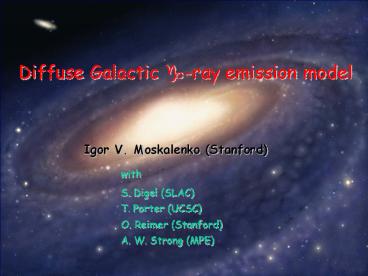Diffuse Galactic ?-ray emission model - PowerPoint PPT Presentation
1 / 20
Title:
Diffuse Galactic ?-ray emission model
Description:
Title: Propagation of Cosmic Rays & Diffuse Galactic Gamma Rays Subject: Propagation of Cosmic Rays in the Galaxy Author: Igor Moskalenko Last modified by – PowerPoint PPT presentation
Number of Views:63
Avg rating:3.0/5.0
Title: Diffuse Galactic ?-ray emission model
1
Diffuse Galactic ?-ray emission model
Igor V. Moskalenko (Stanford) with S. Digel
(SLAC) T. Porter (UCSC) O. Reimer (Stanford)
A. W. Strong (MPE)
2
Diffuse Galactic Gamma-ray Emission
- 80 of total Milky Way luminosity at HE !!!
- Tracer of CR (p, e-) interactions in the ISM
(p0,IC,bremss) - Study of CR species in distant locations (spectra
intensities) - CR acceleration (SNRs, pulsars etc.) and
propagation - Emission from local clouds ? local CR spectra
- CR variations, Solar modulation
- May contain signatures of exotic physics (dark
matter etc.) - Cosmology, SUSY, hints for accelerator
experiments - Background for point sources (positions, low
latitude sources)
- Besides
- Diffuse emission from other normal galaxies
(M31, LMC, SMC) - Cosmic rays in other galaxies !
- Foreground in studies of the extragalactic
diffuse emission - Extragalactic diffuse emission (blazars ?) may
contain signatures of exotic physics (dark
matter, BH evaporation etc.)
Calculation requires knowledge of CR (p,e)
spectra in the entire Galaxy
3
Conventional model vs EGRET data
?0 IC Bremss EG
Conventional model consistent with local p,e
spectra exhibits the GeV excess a factor 2
We must have at least 2 diffuse emission models
with/without the excess
4a-f
4
DC2 diffuse emission model
- galprop ID 6002029RB
- Based on
- Strong,Moskalenko,Reimer, 2004, ApJ 613,962
- Strong,Moskalenko,Reimer,Digel,Diehl, 2004, AA
422, L47 - Optimized to fit EGRET data (GeV excess CR
spectra) - Includes secondary electrons positrons
- Pulsar/SNR source distribution
- Gradient in X-factor (H2/CO)
- Improvements
- new HI, CO data (Digel)
- new interstellar radiation field (Porter)
- fine adjustments to reflect these new inputs
- Examples of model unconvolved and convolved with
EGRET PSF
5
GeV excess Optimized/Reaccleration model
- Uses all sky and antiprotons gammas
- to fix the nucleon and electron spectra
- Uses antiprotons to fix
- the intensity of CR nucleons _at_ HE
- Uses gammas to adjust
- the nucleon spectrum at LE
- the intensity of the CR electrons
- (uses also synchrotron index)
- Uses EGRET data up to 100 GeV
antiprotons
- pbars
- e -flux
- ?-rays
Ek, GeV
protons
electrons
Strong etal 2004
x4
x1.8
Ek, GeV
Ek, GeV
6
Secondary e are seen in ?-rays !
Lots of new effects !
electrons
Heliosphere e/e0.2
sec.
IC
positrons
brems
Improves an agreement at LE
7
(No Transcript)
8
Distribution of interstellar gas
- Neutral interstellar medium most of the
interstellar gas mass - 21-cm H I 2.6-mm CO (standing for H2)
- Differential rotation of the Milky Way plus
random motions, streaming, and internal velocity
dispersions is largely responsible for the
spectrum - This is the best but far from perfect
distance measure available
(25, 0)
CO
25
Dame et al. (1987)
G.C.
H I
Hartmann Burton (1997)
W. Keel
9
New H2 maps (S.Digel)
10
New HI maps (S.Digel)
11
Interstellar Radiation Field
Local ISRF (PS05)
Old model
- Target for CR leptons (IC)
- Energy losses
Optical
IR
- Model components
- Geometrical disk, ring, halo, bar, triaxial
bulge, arms - 87 stellar types (main sequence), AGB exotics
- Dust silicate, graphite, PAH (5Å few ?m)
- Absorbed light gives mid-IR (small grains PAH)
and FIR (0.1-1 ?m grains)
PAH
Scatt.opt.
SMR00 PS05
R0
4 kpc
- Systematic errors
- Star distribution star counts
- Grain properties lab measurements
- Gas/dust proportion extinction curve
- Reasonable parameters
- Compare with ISRF data only at R?
12 kpc
16kpc
12
Distribution of CR Sources Gradient in the CO/H2
CR distribution from diffuse gammas (Strong
Mattox 1996) SNR distribution (Case
Bhattacharya 1998)
Pulsar distribution Lorimer 2004
sun
XCON(H2)/WCO Histo This work, Strong et
al.04 ----- -Sodroski et al.95,97 1.9x1020
-Strong Mattox96 Z-1 Boselli et
al.02 Z-2.5 -Israel97,00, O/H0.04,0.07
dex/kpc
13
Inner Galaxy region
Comparison with EGRET COMPTEL spectral data
Other regions demonstrate equally good agreement
14
Model comparison with data
- Convolution with EGRET PSF
- Important below 1 GeV
- A large effect at low energies especially in
latitude affecting the overall spectral shape - Convolution itself is model dependent -depends on
spectrum, not fully accounted for
15
Effect of Convolution 70-100 MeV
Longitude profile blt5?
Unconvolved Convolved
16
Effect of Convolution 70-100 MeV
Latitude profile llt30?
Unconvolved Convolved
17
Effect of Convolution 0.5-1 GeV
Longitude profile blt5?
Unconvolved Convolved
18
Effect of Convolution 0.5-1 GeV
Latitude profile llt30?
Unconvolved Convolved
19
1-2 GeV
1000 2000 MeV
Convolution effect is negligible
20
Effect of De-Convolution Spectrum llt30? blt5?
Convolved data De-convolved
NB here the spatial convolution correction is
applied to the DATA based on the model. Hence the
DATA changes, not the model (procedure
appropriate for spectra)

